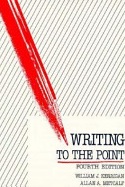There was another bookish lad in the town, John Collins by name, with whom I was intimately acquainted. We sometimes disputed, and very fond we were of argument, and very desirous of confuting one another, which disputatious turn, by the way, is apt to become a very bad habit, making people often extremely disagreeable in company by the contradiction that is necessary to bring it into practice; and thence, besides souring and spoiling the conversation, is productive of disgusts and perhaps enmities where you may have occasion for friendship. I had caught it by reading my father’s books of dispute about religion. Persons of good sense, I have since observed, seldom fall into it, except lawyers, university men, and men of all sorts that have been bred at Edinburgh.
A question was once, somehow or other, started between Collins and me, of propriety of educating the female sex in learning, and their abilities for study. He was of opinion that it was improper, and that they were naturally unequal to it. I took the contrary side, perhaps a little for dispute’s sake. He was naturally more eloquent, had a ready plenty of words, and sometimes, as I thought, bore me down more by his fluency than by the strength of his reasons. As we parted without settling the point, and were not to see one another again for some time, I sat down to put my arguments in writing, which I copied fair and sent to him. He answered, and I replied. Three or four letters of a side had passed, when my father happened to find my papers and read them. Without entering into the discussion, he took occasion to talk to me about the manner of my writing; observed that, though I had the advantage of my antagonist in correct spelling and pointing (which I owed to the printing-house), I fell far short in elegance of expression, in method, and in perspicuity, of which he convinced me by several instances. I saw the justice of his remarks, and thence grew more attentive to the manner in writing, and determined to endeavor at improvement.
About this time I met with an odd volume of the Spectator – I thought the writing excellent, and wished, if possible, to imitate it. With this view I took some of the papers, and, making short hints of the sentiment in each sentence laid them by a few days, and then, without looking at the book, try’d to compleat the papers again, by expressing each hinted sentiment at length, and as fully as it had been expressed before, in any suitable words that should come to hand. Then I compared my Spectator with the original, discovered some of my faults, and corrected them. But I found I wanted a stock of words, or a readiness in recollecting and using them. Therefore I took some of the tales and turned then into verse; and, after a time, when I had pretty well forgotten the prose, turned them back again. I also sometimes jumbled my collections of hints into confusion, and after some weeks endeavored to reduce them into the best order, before I began to form the full sentences and compleat the paper. This was to teach me method in the arrangement of thoughts. By comparing my work afterwards with the original, I discovered many faults and amended them; but I sometimes had the pleasure of fancying that, in certain particulars of small import, I had been lucky enough to improve the method or the language.
The Autobiography of Benjamin Franklin





